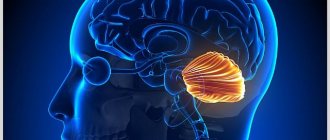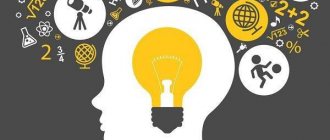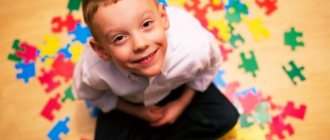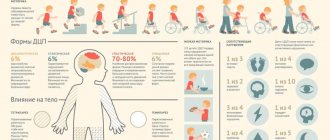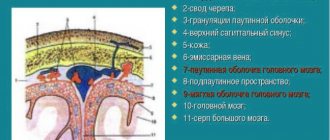Characteristics of children with intellectual disabilities
One of the main characteristics of children with intellectual disabilities is a persistently pronounced decrease in activities aimed at understanding the world. Based on the degree of mental retardation and learning ability, doctors divide such deviations into:
- Idiocy, which is the deepest degree of mental retardation and is characterized by severe impairments in coordination of movements, motor skills and spatial orientation, which in some cases forces them to a recumbent lifestyle. With such intellectual impairment, it is very difficult for children to develop even basic hygienic self-care skills. It is practically impossible for them to comprehend the world around them, and speech either does not develop at all or is developed to a limited extent;
- Imbecility, which is characterized as a milder intellectual disability in children compared to idiocy. Such children have a higher chance of mastering speech and mastering simple work skills;
- Debility, which is considered the mildest course of the disease. The characteristics of children with intellectual disabilities of this form do not allow them to study in regular schools due to the reduced level of mental abilities and the specifics of the emotional-volitional sphere. Difficulties in training and education are associated with the underdevelopment of the analytical and synthetic functions of higher nervous activity. Poor health, somatic disorders and features of the incentive system significantly limit the range of their future professional and labor activities.
In addition, there is a separate group of children with mental retardation. In this case, a feature of children with intellectual disabilities is significant difficulties in studying subjects of the primary general education school curriculum. Such children cannot be classified as mentally retarded, since they demonstrate sufficient ability to communicate and a wide zone of proximal development. The causes of mental retardation can be different. There are mental and psychophysical infantilism associated with:
- Harmful effects on the central nervous system during pregnancy;
- The influence of various factors that led at an early age to cerebrasthenic and asthenic conditions of the body.
In some cases, such children with intellectual disabilities can study in mainstream schools. However, if the disorders are dominated by pronounced cerebrasthenic disorders, they require both therapeutic measures and psychological and pedagogical correction.
Depending on the reasons that led to the development of disorders and the time of exposure to harmful factors, doctors distinguish between many variants of deviations in cognitive activity and the emotional-volitional sphere. The following features are common to all types of mental retardation:
- Immaturity and underdevelopment of emotions;
- Lack of intellectual skills, as well as the inability to obtain the knowledge necessary for such work;
- Low performance due to increased exhaustion;
- Small vocabulary;
- Difficulties in verbal and logical operations, which cause difficulties when it is necessary to solve visual and effective problems;
- An extremely narrowed view of the world around us;
- Inability to use play activities for development;
- Slow perception of current events;
- Low level of self-control, which affects not only learning, but also in life situations.
Definition of mental disability
As the understanding of intellectual disability changes, so do the definitions of the disorder. For example, the characteristics of intellectual disabilities presented by WHO define them as follows: “A state of arrested or incomplete mental development, characterized, in particular, by impaired skills, manifested throughout the entire period of development, affecting all components of intelligence, i.e. cognitive, speech, motor, social abilities. The disorder may occur simultaneously with or without other physical or mental disorders.” (WHO, ICD-10).
Another definition refers to “the inability to achieve an adequate degree of intellectual development (less than 70% of normal) despite receiving appropriate educational stimulation.”
The American Association on Intellectual and Developmental Disabilities (AAIDD) defines intellectual disability as follows: “Intellectual disability is a diminished ability characterized by significant limitations in intellectual functioning and adaptive behavior, as reflected in conceptual, social, practical adaptive skills. The disorder appears before the age of 18.” In addition to the 18-year threshold (the onset of intellectual impairment in adolescents), some authors point to an earlier period - a 2-year threshold, and impairment developing after this age is called dementia.
AAIDD sets out 5 assumptions for applying the previous definition:
- The decrease in current functionality must be judged in relation to the environment and society typical of the age and culture of the individual.
- Recognizes cultural and linguistic diversity.
- Takes into account individual differences in communication, perception, movement, behavior.
- Each person, in addition to his limitations, takes into account his strengths.
- Simultaneously with determining a person’s impairment, an individual target support system should be developed - with it, the quality of life of a person with intellectual impairment will be improved as a whole.
From this definition, it is clear that mental retardation is variable. It does not depend solely on the damage to the person, but also takes into account the influence of the external environment. Particular attention is paid to the importance of targeted support based on the specific skills and needs of people with mental disorders.
Today, various methods and approaches are used to diagnose intellectual disabilities, allowing one to take into account different views on the problem. These approaches guide the mission of services provided to people with disabilities.
Learning ability
Children diagnosed with mental retardation have very different abilities and abilities to communicate with others. Some of them can attend a regular school, successfully communicate with adults and peers, solve problems and master the general education program. Their physical development proceeds normally, and outwardly such children are no different from healthy children.
Children with severe intellectual disabilities often cannot cope with ordinary tasks, so they have to be taught in specialized institutions or at home.
Many children with mild mental retardation are able to study in regular schools. These are quite smart kids, whose development is not much inferior to that of their peers. An important role here is played by educators and teachers, who should be especially attentive to such children, since they are more often susceptible to feelings of helplessness and disappointment.
The expectation of failure, which is reinforced in the absence of a competent approach on the part of the teacher, leads to the fact that children are prepared in advance for the fact that they cannot solve the problem assigned to them, even if in fact they are capable of solving it. Children with mental retardation, seeing a negative attitude towards themselves from teachers, expect less success from their actions and are content with minimal results, although they can achieve much more.
Parents of sick children often face the question of what to choose: a regular school or a specialized institution? The answer depends on the diagnosis. Children with mild mental retardation can study in regular schools and successfully communicate with peers, provided they have support and encouragement from adults. Children whose intellectual functions are significantly impaired are at risk of being isolated, even if admitted to a regular school or kindergarten. Normal children prefer to play and communicate with peers who are similar to them. Therefore, sick babies will find themselves in a vacuum. It won't do them any good.
The development of children with significant intellectual disabilities is best entrusted to specialists who know how to approach them. In special groups of kindergartens, such children are taught according to a special program, which helps to correct developmental deviations.
“Correction and development of the personality of students with intellectual disabilities” (methodological manual)
Sea waves
Target:
reducing emotional and muscle tension, switching attention from one type of activity to another.
If an adult gives the command “Calm!”, all the children in the class “freeze.” When the “Waves” command is heard, the children take turns standing at their desks. Those children who sit at the first desks stand up first. After 2-3 seconds, those sitting at the second desks rise, etc. As soon as the turn reaches the inhabitants of the last desks, they stand up and all clap their hands together, after which the children who stood up first (at the first desks) sit down, etc. .
At the signal from the “Storm” teacher, the nature of the actions and the sequence of their implementation is repeated, only the children do not wait 2-3 seconds, but stand up one after another at once.
You need to finish the game with the command “Calm”.
Clowns are fighting
Target:
removing verbal aggression.
The clowns showed the children a performance, made them laugh, and then began to teach the children to swear, calling each other “vegetables and fruits.” For example: “You,” says the clown, “are cabbage!” And the child answers... (pause for the child to come up with an answer)
. “And you,” continues the clown, “are strawberries.” Another child responds (scolds the adult). Attention is drawn to adequate, angry intonation. Children can choose pairs, change partners, “scold” together, or take turns “scold” all the children. An adult directs the game, announces the beginning and end of the game with a signal, and stops it if other words or physical aggression are used.
Then the game continues, changing the emotional mood of the children. “When clowns taught children to swear, parents didn’t like it.” The clowns, continuing the game, teach children not only to swear with vegetables and fruits, but also to affectionately call each other flowers. For example: “You are a bell...” ( the child affectionately calls the adult
). Intonation must be adequate. Children are again divided into pairs, etc. and affectionately call each other flowers.
Orchestra rehearsal
Target:
give vent to negative emotions, raise vitality.
Materials:
An audio cassette with a recording of lively, playful music that the children in your class will enjoy.
Instructions:
How many of you have seen the conductor? You noticed how he moves while conducting the orchestra. Now each of you will have the opportunity to become a conductor. When I turn on the music, you can all stand up and start conducting an imaginary orchestra. “Conduct” with your hands, arms, knees, legs and your entire body to “show the musicians how they should play.”
Duh-tibi-duh!
Target:
removing negative moods, increasing emotional tone.
Instructions:
I will tell you a special word now. This is a magic spell against bad mood. For this word to really work, you need to do the following. Start walking around the class without talking to anyone. As soon as you want to talk, stop in front of one of the children and angrily say the magic word three times - “tuh-tibi-duh!” At this time, the other student should stand quietly and listen to you say the magic word, he should not answer anything. But if he wants, he can answer you in the same way - three times angrily and angrily say: “Tuh-tibi-duh!” After this, continue to walk around the classroom. From time to time, stop in front of someone and angrily, angrily say this magic word again. For it to work, it is important to say it not into emptiness, but to a specific person standing in front of you.
Recommendations for parents and teachers on the development of intelligence in children consultation
Recommendations for teachers and parents on developing students' intelligence.
Prepared by the teacher:
Rud N.G.
These methods do not require special training. It is enough to be attentive to children and have time to study and play with them.
Development of attention:
- develop auditory attention with the help of didactic games,
- change forms of activity frequently,
- use game elements in classes,
- learn to recite instructions several times,
- observe and discuss with children what they hear and see more often,
- learn to consciously direct attention in accordance with the goal,
- learn to focus on a known activity, concentrate your attention on it without being distracted,
- create incentives that will organize the child’s attention,
- to develop attention, use games with rules and dramatization games.
Games and exercises:
- “Don’t say yes or no, don’t wear black and white.” The adult asks the child questions. The child answers them, but should not name forbidden colors and not say “yes” and “no”,
- puzzle games,
- puzzles,
- "Find differences",
- “Find two identical objects”
- "Be careful". Performing gymnastic exercises according to verbal commands,
- “Magic word”, An adult shows the exercises. And the child repeats them only in that case. if an adult says "Please"
- “Where was it?” The child remembers objects lying on the table; then he turns away. The adult moves the objects and the child then points out what has changed.
- “Name what you see.” The child must name as many objects in the room as possible in 1 minute.
- “Dwarves and Giants.” The child must listen to the adult’s verbal instructions. Not paying attention to his actions.
Memory development:
- develop the ability to voluntarily recall necessary memories,
- teach a culture of memorization,
- learn to remember the sequence of events,
- learn to use mnemonic techniques when memorizing,
— teaches to use an image as a means of developing voluntary memory,
- learn to repeat, comprehend, connect material for the purpose of memorization. Use connections when remembering
- promote the ability to use auxiliary means for memorization.
Games and exercises:
- “Memorize the items.” Learn to remember and reproduce information
- “Detective.” Develop voluntary memorization; the child looks at 15 pictures for 15 minutes, after which the pictures are removed; the child must name the pictures that he remembers,
- “Pyramid”. Develop short-term mechanical memory. The adult first calls the child one word, the child must immediately repeat it; then the adult names two words, the child repeats them, then three words, the child repeats, etc.
— “What did you see during the holidays?” The adult asks the child questions about the events taking place during the holidays,
— “Pathfinder.” The adult shows the child the object and says that he will now hide it in the room; the child must find the hidden object,
- “Clothes” the child must remember in what order he put on the items of clothing in the morning,
- “Draw the same one.” An adult draws a simple object on a sheet of paper, then the sheet is turned over and the child must draw the same object.
- “I put it in a bag.” An adult puts different objects into a bag in front of the child, the child must remember what is in the bag,
- "Short story". An adult reads a short story, the child must retell it,
- “Tower”. The child is shown a schematic representation of a tower consisting of many geometric shapes, the child must remember these shapes and name them.
"Stick Figure". The adult lays out a stick figure, the child remembers it and lays out the same one from memory.
Development of perception:
- teach children to distinguish objects by touch,
- develop the ability to identify features in an object,
- learn to correlate objects by size,
- teach methods of discerning observation,
- develop observation skills, teach to carefully and consistently examine objects and phenomena,
- help to comprehend the connection between objects and perceive the image as a whole,
- develop the ability to assemble a whole from parts,
- learn to select objects and correlate their size using a verbal description. Act in accordance with verbal instructions,
- distinguish the main signs of different seasons,
- learn to navigate in space using a plan diagram,
- consolidate spatial representations: left, right, above, below, in front, behind, between, next to,
- form sensory standards of form,
- contribute to the development of the ability to analyze a subject. Highlight small details in it,
- contribute to the development of understanding of the connection between the drawing and reality.
Games and exercises:
- “Shifters.” Transform a circle, triangle, square into any design,
- “How to get to the bunny”, “Journey around the room”, “Where you go, what you find.” Orientation in space according to the plan diagram,
- "Stars on the sky". Correlation of schematic images of the constellations “Eagle”, “Swan”, “Fish” with artistic ones,
- “Find out the form.” Recognize the shape of a geometric figure in surrounding objects,
- "Find differences". Learn to find differences in similar objects,
- “Build according to height.” Arrange objects in a row according to their height,
- “Fold the picture.” Compose a whole picture from parts,
- "What I'm talking about?". An adult describes an object, and the child must guess. What subject are we talking about?
- "What season?". The adult names the season, and the child names its signs,
- “Guess the object.” An adult draws the outline of an object with a dotted line or dots; the child must recognize the object.
Development of thinking:
- develop mental abilities through mastering the actions of substitution and visual modeling in various types of activities,
- learn to form a group of individual objects,
- learn to identify objects and generalize them according to their characteristic features or purpose,
- learn to understand the meaning of a literary work, reproduce the content of the text in the correct sequence using questions,
- learn to compare objects,
- learn to correlate a schematic image with real objects,
- encourage you to draw your own conclusions,
- learn to answer questions. Draw conclusions
- create a complexly organized environment so that the child can interact with different objects,
— promote knowledge of the properties of various materials. Their functional potential, the creation of images, models of real objects through visual activities (sculpting, appliqué, drawing, etc.),
- promote understanding of the content of life situations, imitation and playback of them with the replacement of some objects by others,
- learn to establish cause-and-effect relationships,
- develop thinking using fairy tales, sayings, metaphors, figurative comparisons,
- learn to identify and connect those aspects of the situation, properties of objects and phenomena that are essential for solving the task at hand,
- promote the transition to solving problems in the mind.
Games and exercises:
- “Lay out the pictures.” Learn to see the sequence of events
- “Finish the word.” Learn to finish a word with the initial syllable,
- “Find the extra object”, “Find the extra figure in the row.” Learn to classify objects according to their characteristics and purpose,
- "Creativity". The child is shown objects that do not have a specific purpose; the child must figure out how to use this item,
- “Antonyms.” The child is called a word, and he must name the opposite meaning. For example: “heavy - light”, “strong - weak”, etc.
— “Unicube”, “Loto”, “Domino”, mosaics, constructors,
- puzzles.
Development of fine (fine) motor skills.
- Straighten your hand, close your fingers tightly and slowly squeeze them into a fist. Perform with each hand alternately. (5 times)
- Place your hand firmly on the table, palm down, and bend your fingers one by one: middle, index, thumb, little, ring fingers. Perform alternately with each hand. (5 times)
- Straighten the hand and alternately attach the ring finger to the little finger, the middle finger to the index finger. (5 times)
- Clench your fingers into fists and rotate your hands in different directions. First, alternately with each hand. (5 times) Then - with both hands at the same time. (5 times)
- Bend and straighten your fingers. Spread your fingers as wide as possible, then close them 5 times, alternately with each hand, then with both hands at the same time. (5 times)
- Place your hands palms up. Raise one finger at a time, first on one hand, then on the other. Repeat this exercise in reverse order. (5 times)
- Place your palms on the table. Alternately raise the fingers of both hands at once, starting with the little finger. (5 times)
- Hold the pencil between your middle and index fingers. Then bend and straighten these fingers. (5 times)
And at the same time focusing on yourself
There is nothing surprising in this: people with low EI find it difficult to understand the feelings of others, and therefore they try every situation and circumstances on themselves, and therefore turn the focus of any conversation onto themselves. They do not open up themselves and do not give others the opportunity to open up.
When asking a question, such people do not seek to hear the interlocutor’s answer and generally hardly give him the opportunity to speak. Which, of course, hardly motivates him to continue communicating. In addition, such people often seek to manipulate and control others.
Classification of mental disorders
The following classification describes some of the characteristics common to people with certain degrees of intellectual disability. However, it is important to emphasize that due to the individuality of each person, it is not possible to approach people with mental disorders solely on the basis of these characteristics.
Mild degree (IQ 50-69)
These children are able to follow some rules of logic, but their communication lacks most abstract concepts; they use concrete notations. They predominantly achieve complete independence in personal care and practical household skills, even if their development is slower than normal. This provides a relatively good opportunity for their manifestation in the labor market.
Average (IQ 35-49)
The learning of these children is limited by mechanical conventions. To fix something, there is a need for frequent repetition. They can cope with normal habits, simple skills, especially self-care, and perform simple work tasks without the need for speed and accuracy.
Severe (IQ 20-34)
The developmental characteristics of a child with intellectual disabilities are represented by the ability to understand only basic contexts and relationships. Limitations are also evident in language skills. He masters several erroneously articulated phrases, which he also uses imprecisely. Sometimes children with this degree of intellectual disability do not speak at all. Their training is highly limited and requires long-term effort. However, through systematic, skilled rehabilitation and educational care, it is possible to promote the development of motor skills and communication abilities of these people, which will improve their quality of life.
Deep degree (IQ ≤ 19)
Often we are talking about a combined disorder. Cognitive abilities hardly develop, as does articulate speech. People with this degree of damage are most able to distinguish between known and unknown stimuli and respond to them with pleasure or dislike.
Other mental disorders
Determining the degree of intellectual impairment is difficult due to associated somatic or sensory disorders, autism or severe behavioral defects.
Unspecified mental retardation
This designation is used in cases where childhood mental deficiency is proven, but it is difficult or impossible to determine its level, therefore, to classify a person into one of the previous categories.
Mild mental retardation
You can begin working with children with intellectual disabilities only after you have a complete picture of their condition. So, if you have a child with mild mental retardation, then working with him will be quite simple. He rarely has problems communicating with a group of peers; such children can learn the material on their own, but not to the same extent as the majority of children. But despite this, they attend regular classes in secondary schools. Over the course of life, this diagnosis does not go away, but people can easily live a normal life, work in an enterprise, have friends and family. Perhaps sometimes they will need outside help, but close people are able to help them without the involvement of specialists.
Report on the topic: Disorders in the intellectual development of a child, their taxonomy and statistics
“Impairments in the intellectual development of a child, their taxonomy and statistics.”
Intelligence
(Latin – cognition, understanding) is the highest level of development of the human essence, expressed in the mental abilities of a person, integrating the cognitive, sensory and volitional spheres. In practical life, intelligence is conventionally reduced to human thinking, only slightly expanding the area of functioning
Prerequisites for the development of intelligence
are
cognitive functions
- attention, memory, spatial perception, thinking, as well as
psychophysiological characteristics
- performance, initiative, cognitive interest. They can be the central symptom of the disease or one of the secondary ones. There are no exact data on the prevalence of intellectual disabilities; they are reliably more often detected among the rural population, which is explained by simpler living conditions that require less effort to adapt.
Intellectual disabilities in children
Intellectual disabilities in children
– mental development deviations of different origin, direction and manifestations.
Intellectual impairment
– qualitative and quantitative deviations in the development of mental abilities.
Symptoms
include insufficient ability to solve life and educational problems, difficulties in orienting in a new situation, lack of knowledge, skills, abilities, limited vocabulary, reduced level of abstract logical thinking. Diagnosis is carried out by a psychiatrist, neurologist, psychologist. Additionally, instrumental studies of the brain may be prescribed. The treatment plan is drawn up individually and involves pharmacotherapy, psychocorrection and social rehabilitation.
Mental retardation
is a clinically heterogeneous group. This is the name of a condition that occurs after various types of damage to the central nervous system of a child in the period before the development of his speech, i.e., until approximately one or two years of life. Such lesions include hereditary and intrauterine damage to the fetus, natural trauma and asphyxia, as well as other diseases that affect the central nervous system of the child until about two years of age.
According to G. E. Sukhareva, three groups of pathogenic factors
, causing the occurrence of oligophrenia: 1) inferiority of the generative cells of the parents (including hereditary diseases and pathology of embryogenesis); 2) harmful effects on the fetus during intrauterine development, birth trauma; 3) postnatal lesions of the child’s nervous system (infections, injuries, burns) up to three years of age
Causes of intellectual disabilities in children
Intellectual disability develops as a result of the negative influence of endogenous and exogenous factors. The more intense and early the exposure, the more serious disorders are determined in the child. The following groups of reasons are distinguished:
Genetic changes.
Deviations in intellectual development are determined by chromosomal abnormalities - trisomy (Down syndrome), chromosome deletions, uniparental disomies; with dysfunctions of individual genes (autism, Rett syndrome).
Perinatal damage to the central nervous system.
Hypoxia caused by maternal diseases (cardiovascular, endocrine pathologies, kidney, liver diseases), incompatibility of the pregnant woman and the fetus according to the Rh factor, the ABO system, intrauterine infections, intoxication, radiation exposure, severe emotional stress during pregnancy, and prematurity have a negative impact.
Natal damage to the central nervous system.
Complicated childbirth, accompanied by asphyxia, blood loss, and fetal injuries, can lead to organic and functional brain disorders.
Postnatal damage to the nervous system.
Intellectual impairments of varying severity develop with neuroinfections (encephalitis, meningitis), epilepsy, severe endocrine, autoimmune diseases, intoxication, traumatic brain injuries, dystrophies, and after clinical death.
Mental, neurological disorders.
Intellectual disorders arise against the background of behavioral, emotional, volitional defects, and pathologies of the analytical systems.
Social factors.
Deviations of intellectual development are detected in disharmonious family relationships, an asocial lifestyle of parents, pedagogical neglect of children, and long stays in hospitals.
Classification
Intellectual disabilities in childhood are divided into quantitative and qualitative. The first group includes:
- Impaired mental function.
Slow maturation of the morphofunctional systems of the brain occurs under the influence of unfavorable factors and is expressed by the immaturity of psychomotor and cognitive functions.
- Mental retardation.
It is a mental retardation - a persistent congenital or early acquired impairment of intelligence.
There are three degrees:
mild (moronicity), moderate (imbecility), severe (idiocy). - Dementia.
Acquired persistent or progressive dementia, developing as a result of the loss of formed intellectual functions.
Qualitative intellectual impairments in children are caused by uneven development of mental, psychophysiological, emotional and volitional functions.
We are talking about a disorder in cases where the uniqueness of the intellect prevents the child from adapting to the environment at the level of everyday self-care, social interactions, and mastering educational skills. Qualitative changes are found in schizophrenia, early childhood autism, diseases of the sensory organs, and speech pathologies.
Statistics:
According to available data in the world, children with intellectual disabilities make up about 2.5% of the total child population. Our foreign colleagues often indicate other, higher percentages, which is due to the use of slightly different criteria when diagnosing a child’s mental development.
Today, statistics indicate a fairly stable percentage relationship between various categories of developmental disorders within the main age groups. Thus, in terms of prevalence within the child age group, the first place in number is occupied by children with educational difficulties (more than 40%); second place - with intellectual disabilities (about 20%), third - with speech disorders (also about 20%), the remaining disorders in the aggregate make up less than 20%.
Here are some statistics from the Ministry of Education of the Russian Federation
. Currently, there are 1.7 million children living in the Russian Federation, i.e. 4.5% of the entire child population of the Russian Federation are classified as children with disabilities and need special education. This number includes more than 353 thousand preschool children; 63.6% of such children are in preschool educational organizations along with ordinary children. The system of the Ministry of Education has opened a network of specialized (correctional) kindergartens with 24-hour stay for children, and specialized (correctional) children's homes, as well as preschool groups at special boarding schools. They accept children aged 3-4 to 7-8 years. The selection of children to these institutions is carried out on the basis of the conclusion of medical and pedagogical commissions. The decision to enroll a child in a specialized (correctional) preschool institution and to withdraw him is made by a psychological-medical-pedagogical commission (PMPC) consisting of a representative of the department of education, a representative of the health department and members of the commission: an oligophrenopedagogist, a speech therapist, a neuropsychiatrist (or a child psychiatrist ). Psychological, medical and pedagogical commissions are organized by regional or city departments of education departments.
Thus, more than 500 thousand children and adolescents of school age are studying in the special education system. Some children and adolescents do not have the opportunity to study due to the lack of special specialized educational institutions on their territory (in the region, region, republic). Thus, almost every second child with a musculoskeletal disorder is deprived of the opportunity to receive an education in a specialized special educational institution, and general educational institutions today do not have the conditions and specialists to educate children in this category.
Development
A healthy child from birth begins to explore this new and amazing world. He begins to touch everything, taste it, and check the strength of objects. This is the only way a child will be able to receive all the information he needs about the world he finds himself in. It's no secret that he speaks his first conscious and understandable words at one and a half or two years. Some are a little later or earlier, but that’s the average.
As for the development of children with intellectual disabilities, they go through all these stages a little later, depending on the form in which this disorder is expressed. They are no different from their peers, since they are also interested in toys and outdoor games. Communication with peers the same age is especially easy for children with mild mental retardation. If they can find friends, and this is not so difficult, they will fit into the team perfectly and can even become recognized leaders there.


